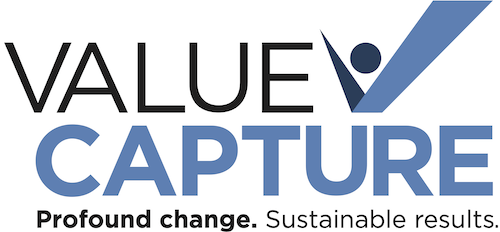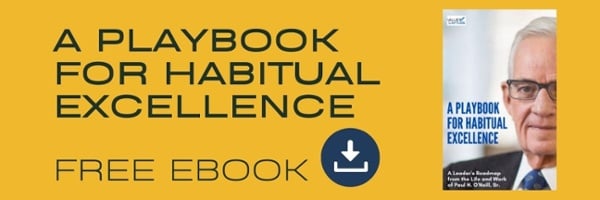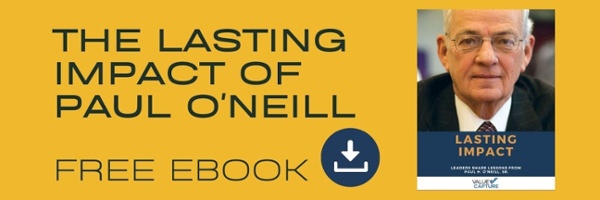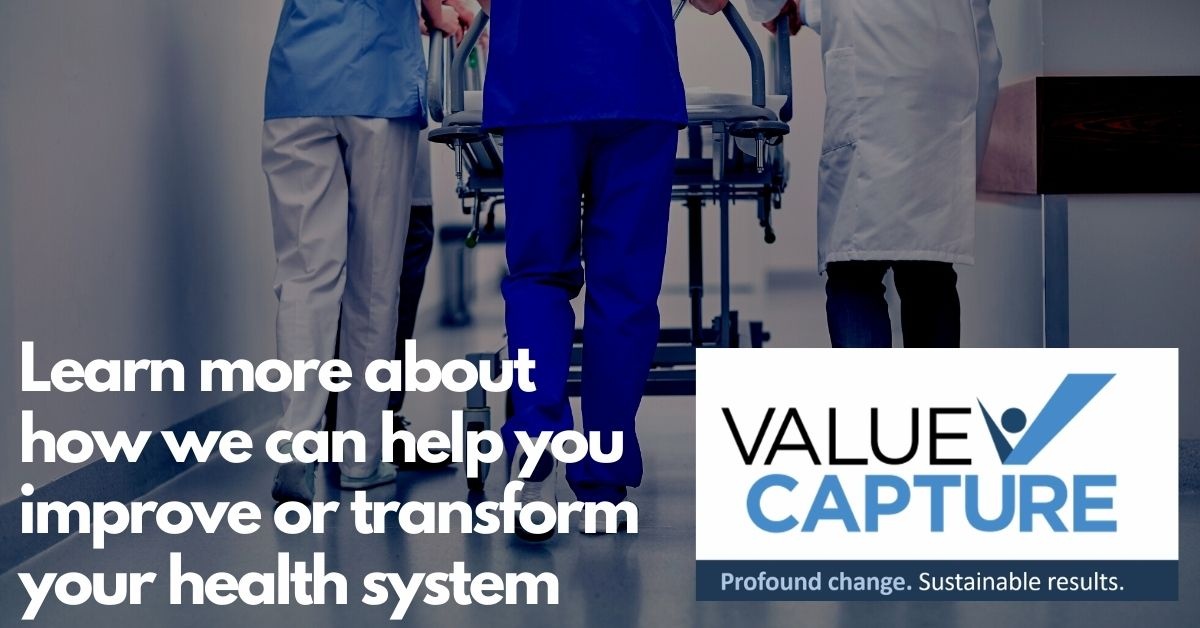What is "Habitual Excellence?"
And what should that mean for your healthcare organization?
"Habitual excellence" is a phrase that we use a lot at Value Capture. Our clients use this phrase.
But what does it mean?
It's the title of our podcast series, but it's much more than that.
On This Page:
On this page, you'll find:
- Origin and inspiration for the phrase "Habitual Excellence"
- Why "leading with safety" is part of the pathway to organizational excellence
- What leaders need to do, and what only senior leaders can do
- Examples (and results) from healthcare and beyond
- Additional resources, including eBooks, a video, a podcast episode, and more
Inspired by CEO Paul O'Neill
The phrase, as we use it, has its origins in one of our key mentors, the late Paul O'Neill, who was, among other things, the CEO at Alcoa, U.S. Treasury Secretary, and our first non-executive Chairman here at Value Capture.
"Habitual Excellence" is a phrase that O'Neill would use in speeches, including the edited transcripts you can find in our free eBook, A Playbook for Habitual Excellence.
But more importantly, it wasn't just a slogan -- it wasn't just words. "Habitual Excellence" is something that O'Neill aimed for and worked toward. He inspired transformational change as a leader, with the state of "Habitual Excellence" being a key goal (and one of the pathways for achieving "theoretical limits" goals including "zero harm").
You Can't be "Partially Habitually Excellent"
Here's how O'Neill introduced the concept of Habitual Excellence in one of those speeches:
"...habitual excellence to me means everything. One of the things I discovered, in the different privileged [leadership] responsibilities I’ve had, is that it’s not possible for an organization to be partially habitually excellent. There’s a tendency to regress toward the mean."
"One of the frustrations in health and medical care across the country — I’m all over the country and have been now for the better part of two decades talking about these things — is that people are inclined to do projects. It’s amazing how much progress you can make with a project for a period of time."
"It’s also amazing how there’s an erosion of success if you’re surrounded by stuff that’s not habitually excellent. It’s really hard to protect an excellent experience if your interfaces are with parts of the organization that aren’t excellent, because they pull you down."
"I believe organizations are either habitually excellent or they’re not."
"You can’t be partially habitually excellent. You need to strive for the whole thing. I have to tell you, I didn’t get a lightning bolt. I’ve been on a lifelong learning journey."
Leading with Safety
How did O'Neill get Alcoa started on their path to Habitual Excellence? By leading with safety.
O'Neill told the organization that safety was a "precondition, not a priority." Making public statements that "nobody should ever get hurt at work" were followed by concrete actions that helped every person in the organization know that he meant what he was saying.
O'Neill said, "It was the beginning of coalescing the people around, for me, a really important part of habitual excellence. In order to have a workplace where people never get hurt at work, you have to identify every risk.
If there is an incident, you need to be on it immediately. You need to do a root-cause analysis. Then the power of large organizations, once you’ve done that, if you have absolute transparency and complete information sharing, you don’t have to learn the same lesson over, and over, and over again.
That’s how you leverage an organization:
By learning from everything gone wrong and sharing it across all of the artificial boundaries that we’ve created with organizational designs so that everyone is a beneficiary of learning."
O'Neill learned, and demonstrated through others, that these leadership behaviors are necessary to drive Habitual Excellence:
- Identifying safety risks or the causes of harm
- Creating an environment where it's psychologically safe for people to speak up
- Removing excuses in the organization when identified (including lack of budget)
And as a result:
- Through action and scientific problem solving, the organization gets better at improving
- These cultural and behavioral elements lead us not just toward Zero Harm but toward world-class performance in all dimensions
Read a more detailed summary of the "Playbook."
The Things Only a Leader Can Do
O'Neill realized that there were certain things that only he, as CEO, could do.
"There are some things you can’t do from the bottom of the organization. As much as you may want to do it, you cannot create the fundamentals for habitual excellence from the bottom of the organization. It’s the leaders’ responsibility to create the cultural conditions in an organization where people can answer yes to three questions every day."
"An organization has the potential for habitual excellence, people can say yes to those three questions every day."
What are those three questions? Read more.
Learn more about the "playbook for habitual excellence" in this free eBook:
Also, see this blog post by Bill Boyd:
Results from Alcoa — No Tradeoffs
Using this "playbook" as CEO of Alcoa, O'Neill led a huge reduction in employee harm and lost workday injuries, as shown in the chart below (O'Neill was CEO from 1987 to the end of 2000). Industry-wide healthcare worker lost workday rates in the United States during part of that time frame are overlaid (in orange).
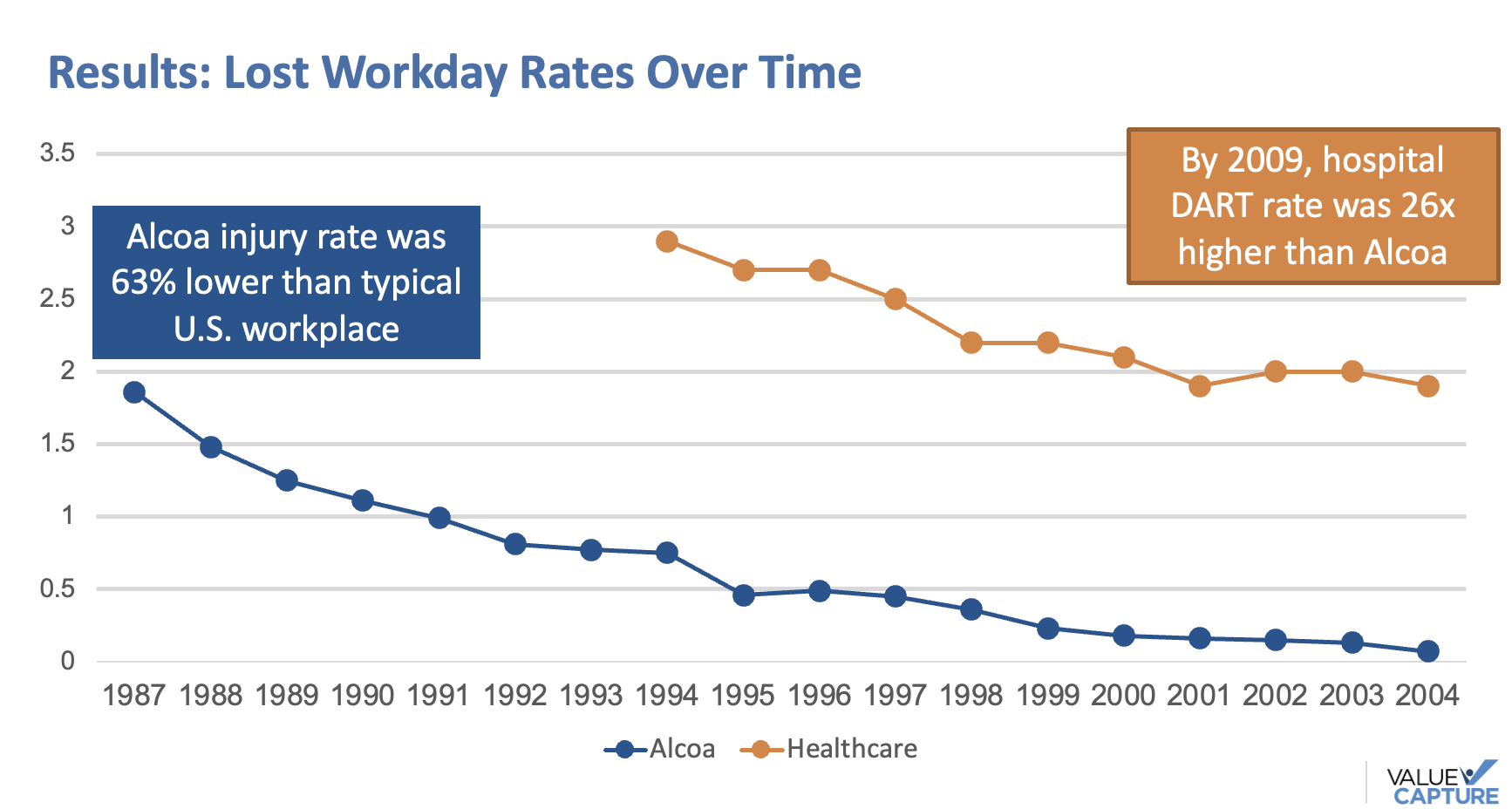
In 1987 when O'Neill became CEO, they were already in the top third of all companies when it came to employee safety, having a 63% lower harm rate than industry as a whole.
They thought they were doing well enough.
Under O’Neill, they accelerated toward zero harm, as you can see. Paul left in 2000, but in 2009 as Alcoa continued to improve, it was 26x safer to work anywhere in Alcoa (mining, smelting, manufacturing, etc.) than it was in an American hospital (the core of Value Capture’s mission is bringing these ideas to healthcare).
Safety Improvement and Financial Performance
Was leading with safety a tradeoff with financial success? Hardly. In fact, O’Neill and the Alcoa community would argue just the opposite — safety was the leading indicator for their financial success.
Alcoa's market cap rose 9x higher during his time as CEO (again, ending in 2000, as shown by the blue arrow). Alcoa stock price (part of the Dow Jones Industrial Average) outperformed the DJIA as a whole over that time.
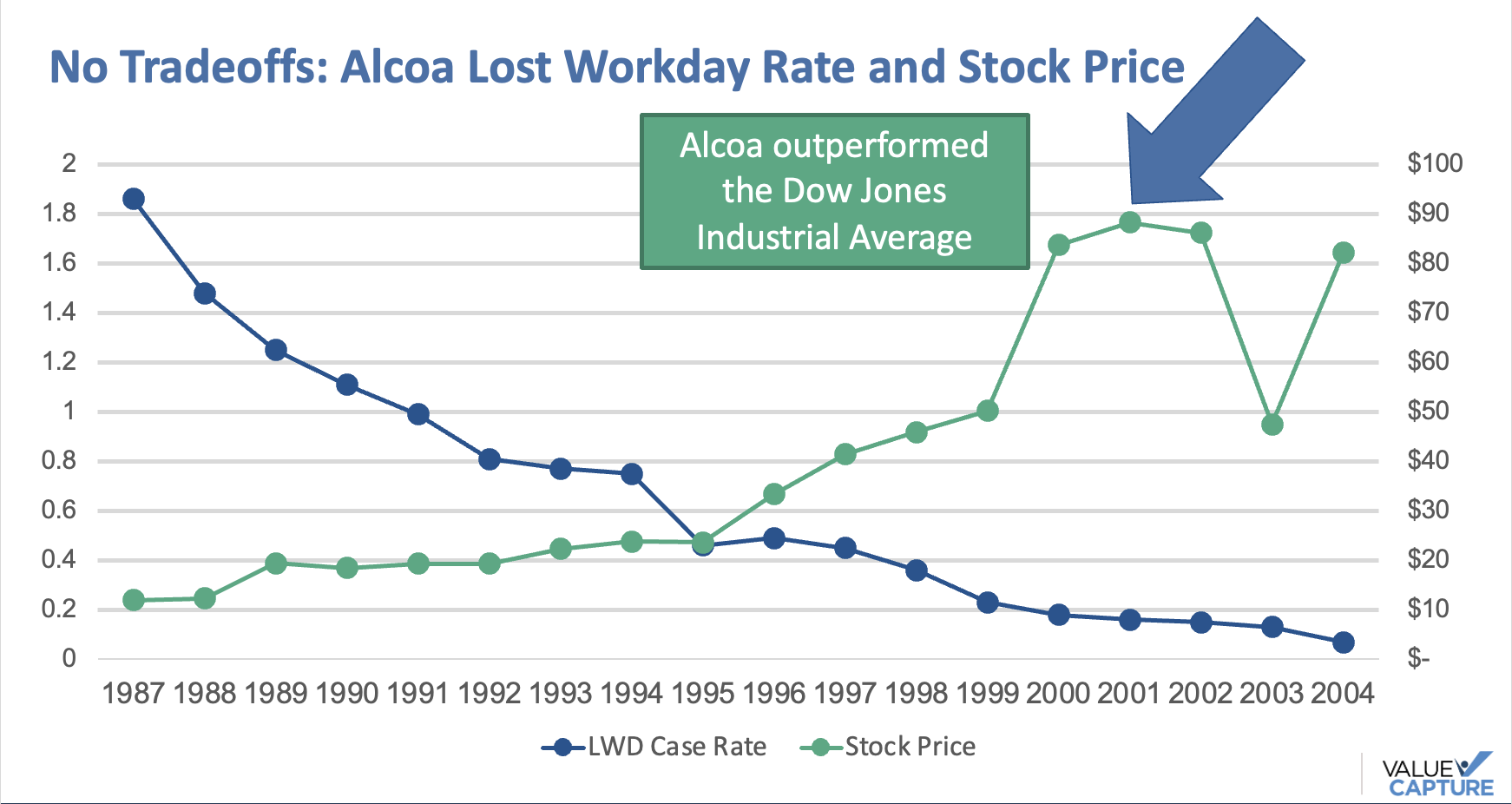
O'Neill taught us to stop accepting tradeoffs that are viewed as necessary or inevitable. Value Capture has learned, through our partnership with clients, that commonly assumed tradeoffs are not laws of nature that must be. In fact:
- We can achieve better safety and better financial performance
- We can achieve higher quality and lower cost
- We can achieve better patient flow along with less harm, better quality, and lower cost
- We can achieve both employee satisfaction and patient satisfaction
- We can achieve higher employee satisfaction and lower cost
"Habitual" Means Neverending Improvement
O'Neill said, before leaving Alcoa:
“If the rate continues to fall after I leave, I will have been a success.”
The improvement at Alcoa, while led by O'Neill as CEO, wasn't all about his leadership. When you develop a culture of safety — and a culture of continuous improvement and scientific problem solving — it becomes self-sustaining, as shown in the chart below:
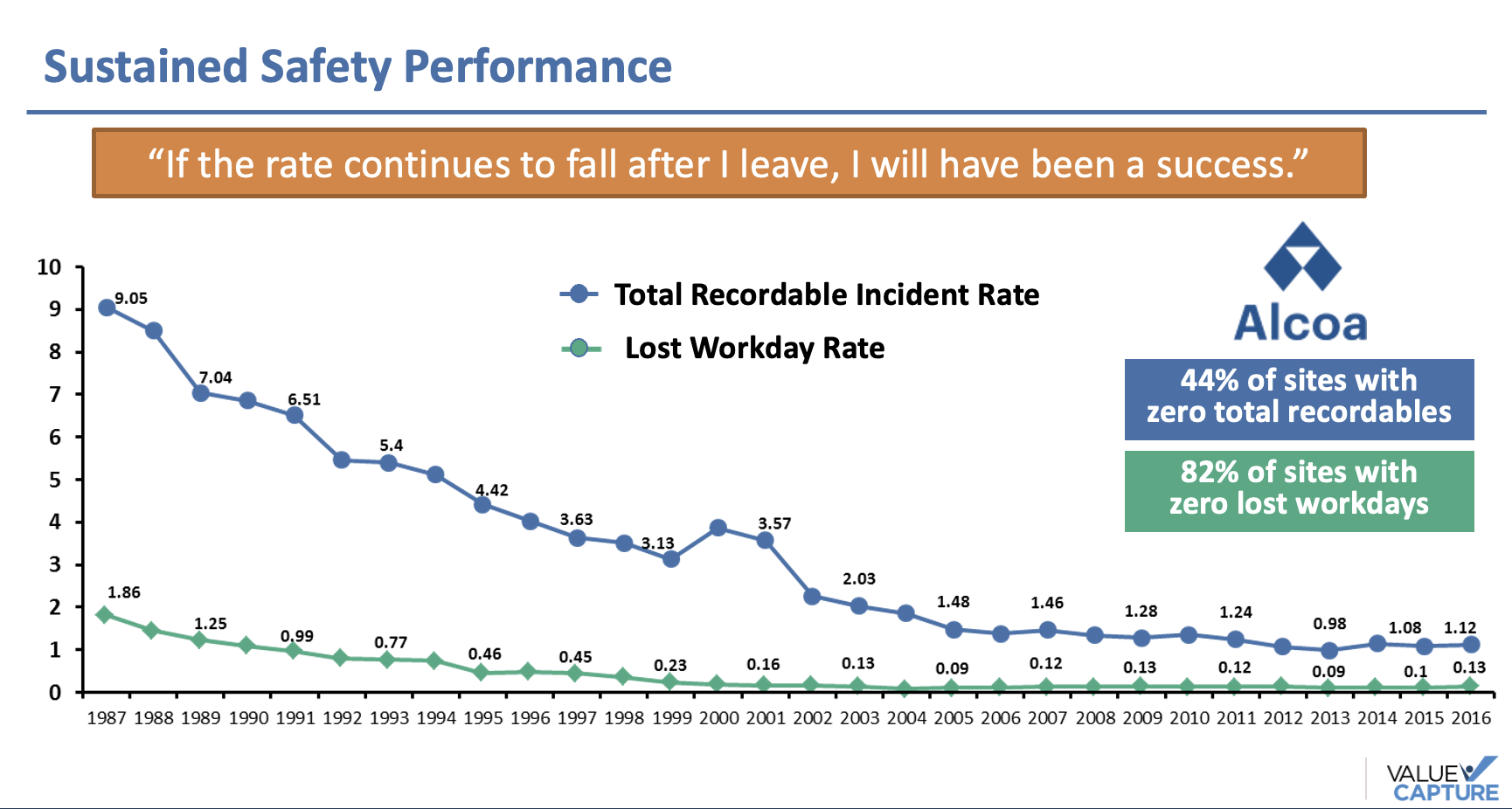
Alcoa became the safest place in the world to work, passing DuPont. Alcoa had achieved:
- 87% reduction in Recordables
- 93% reduction in Lost Workdays
- 44% of sites with zero total Recordables
- 82% of sites with zero Lost Workdays
Talk to Value Capture about how we can help you on this journey.
Watch O'Neill Talk About Habitual Excellence in More Detail:
See the full speech that's referenced above:
Geoff Webster on Habitual Excellence
In episode #5 of our podcast, Value Capture's Geoff Webster, a Senior Advisor and Principal with our firm, talked about the Habitual Excellence concept and what that means to him.
Geoff says, "Habitual Excellence for me is really a state of being, for an individual or an organization, where there's an understanding that the things that you do every single day — the little things and the big things — are what have an influence on whether you get the results that you want."
"I think that you actually can't have Habitual Excellence without aiming for perfect."
Read Geoff's blog post: "A Study in Principles That Drive Habitual Excellence."
Healthcare Leaders Who are Committed to Habitual Excellence
In our second free eBook, Lasting Impact, leaders from many health systems shared their thoughts on Habitual Excellence and what it has meant to them.
Value Capture has been privileged to partner with many clients and their executives who share the values that lead us down the path to Habitual Excellence.
Richard (Rick) Shannon, MD
Dr. Rick Shannon has been a senior leader at many health systems over the past 20 years. When he was at Allegheny General Hospital in Pittsburgh, Dr. Shannon learned directly from Paul O'Neill and remains influenced by him to this day.
From Lasting Impact:
"Richard Shannon, MD, Chief Quality Officer at Duke Health, met O’Neill in 1998... He eventually became involved with PRHI and O’Neill, and says he admires him more than any of the great minds he encountered in his 35 years of medicine as well as 17 years at Harvard Medical School and seven years at the University of Pennsylvania.
Dr. Shannon was so overwhelmed by O’Neill’s approach that he gave up his research career “because he taught me that discovery didn’t have to be confined to a lab. It was a daily exercise in human behavior and in leadership. So I literally gave up what was 40 percent of my effort and began to think along the lines of developing quality platforms in healthcare. By 2003 or 2004, I was a completely different person.”
As a senior leader in healthcare, Dr. Shannon says he has built everything in his organizations around the principles of quality and safety. “Yes, we do have budgets, but I pay no attention to the budgets. I believe that if we do it right, the economics will follow.
That is an O’Neill lesson.
I don’t want to be misleading. There are people in the organization that spend a lot of time on the budget, but not me.
Everything begins with quality, doing the right thing the first time, no defect, no error, no waste is the ‘economically good thing,’ the term that Paul coined of perfect patient care.
And so I lead with an agenda of quality, not mergers and acquisition, not growth, not cost cutting, but the idea that building better clinical outcomes, making our patients better by delivering perfect care the first time, is the economic secret sauce of healthcare. And that was an O’Neill-ism. That was something that emanated from Paul.”
Dr. Shannon added:
"[O'Neill] said to me, ‘Dr. Shannon, I’m really not interested in the reasons why you can’t. I’m interested in what you’re going to do over the next year to improve these outcomes.’"
What results did Dr. Shannon achieve? At Penn:
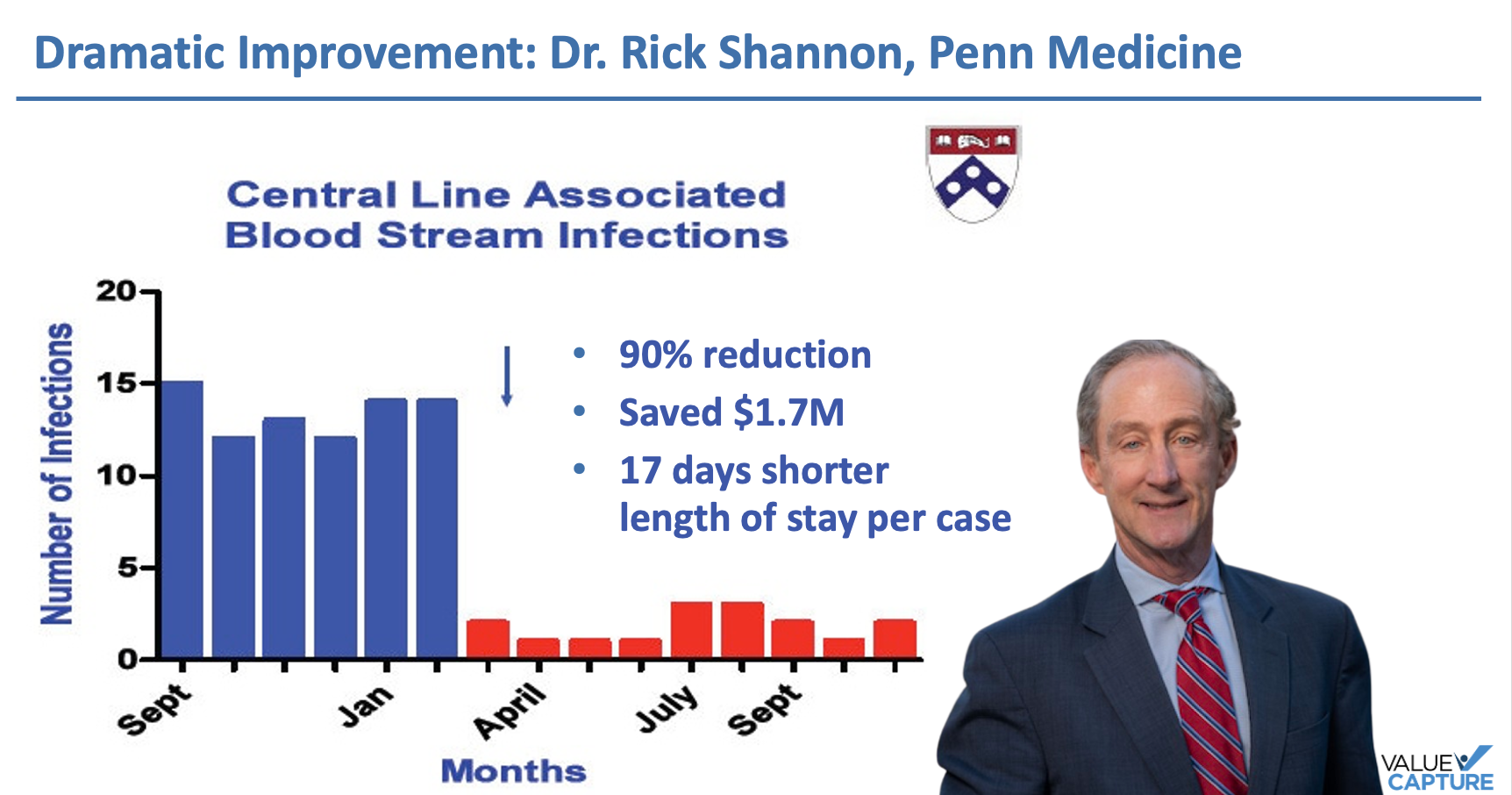
- 90% reduction in CLABSIs
- Saved $1.7M
- 17 days shorter length of stay per case
Again, no tradeoffs.
Some of what was achieved later at UVA Health:
Safety Improvement |
Financial Impact |
|
58 fewer CABSI/63 fewer UTI (62% reduction) |
$2.6M |
|
109 fewer pediatric infections |
$4.2M |
|
53 fewer sepsis deaths (27% reduction) |
$1.83M |
|
36 fewer falls (22% reduction) |
$82,800 |
|
46 fewer pressure ulcers (17% reduction) |
$1.6M |
|
95% reduction in stock-outs |
$3.2M supplies 29,000 hrs nursing staff time saved |
|
96 fewer worker injuries (13% reduction) |
Priceless!!! |
And some longer-term results:
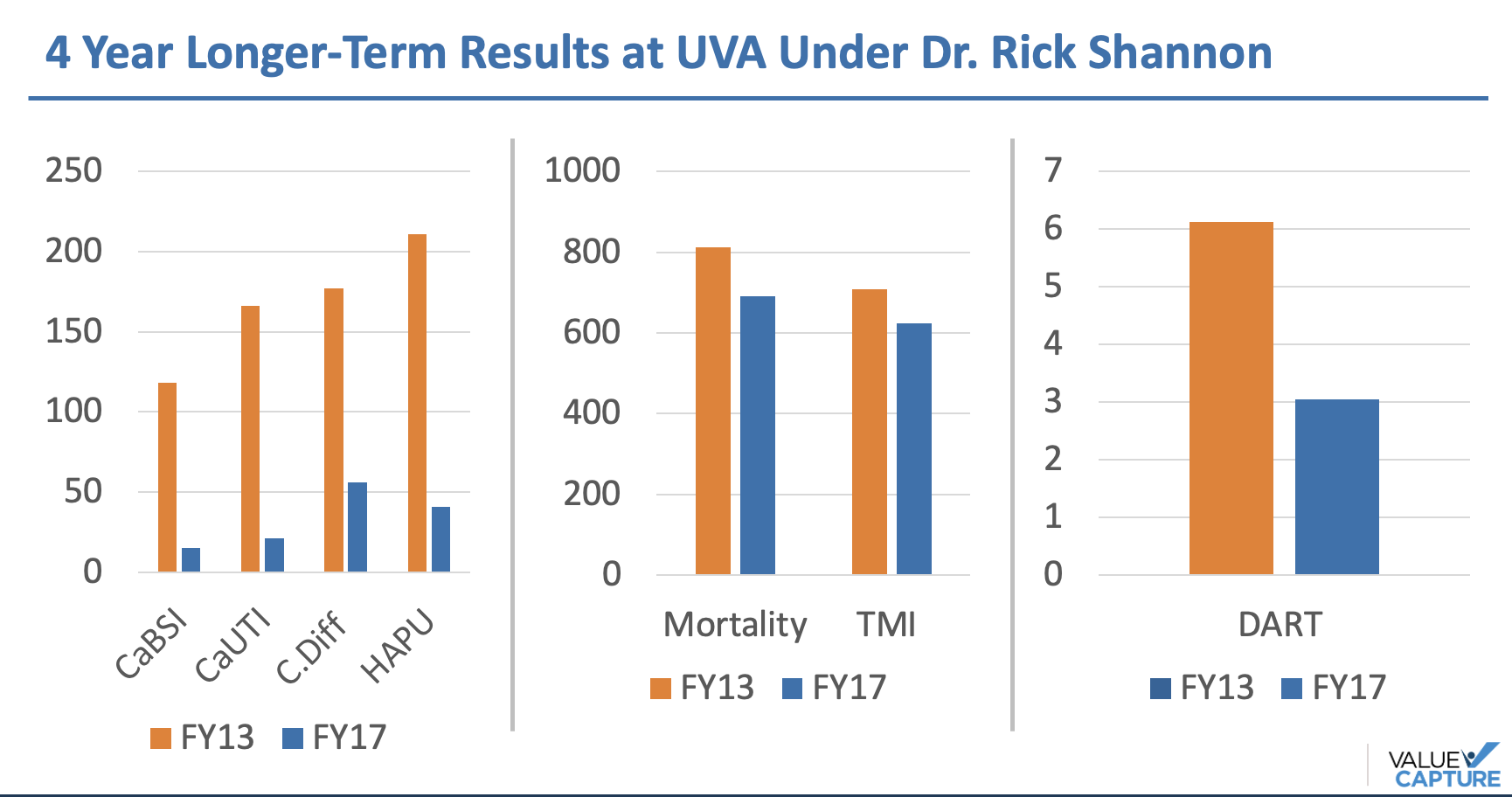
Habitual Excellence is indeed possible in healthcare!
John Toussaint, MD
Dr. John Toussaint is widely viewed as one of the world's leading voices on healthcare improvement, leadership, and "Lean." He was previously the CEO of a health system where he led their Lean Transformation efforts, as documented in many books by Toussaint and others.
From the eBook:
"Dr. Toussaint was able to convince O’Neill to be a founding board member of Catalysis (then known as the ThedaCare Center for Healthcare Value) and, as a member, he attended every meeting.
“He always was very clear about what we should be doing,” says Dr. Toussaint. “He served eight years on the board and was invaluable from the standpoint of his laser-like thinking.
"He would not stand for anything but leadership’s total commitment to habitual excellence."
He would ask things like, ‘Do the organizations in the Healthcare Value Network have metrics around zero harm to employees or zero harm to patients? What are they doing to create that environment?’
We would work with a lot of different organizations in trying to apply lean thinking, but for him, it was about "are they really committed to zero?" He kind of kept us on a straight and narrow path in terms of [being] focused on employee safety. He was always asking, ‘OK, so when we talk about True North, where does safety come in? Where does employee safety come into that?”
Sutter Health
Read the free whitepaper: "Pursuing Habitual Excellence."
“Safety is the best place to start to engage every employee in improving the work,” says [Value Capture Vice President of Advisory Services Didier] Rabino. “It helps to develop the idea of a theoretical limit of zero safety incidents for workers and patients, eyes to see issues, and emotional and professional safety to elevate all problems in full transparency in real time. Safety is also a lever to develop not only problem-solving capabilities, but also coaching skills.”
"As employees become emotionally and professionally safe to point out and solve safety problems — without fearing a negative response — it leads to ingrained behaviors and the confidence to apply those behaviors to non-safety issues."
Webinar: Habitual Excellence Begins With Safety
Check out the recording of our free webinar: "Habitual Excellence Starts with Safety — Before, During, and After a Crisis."
Ken Segel, our Value Capture CEO, was joined by Michael Bundy, Chief Executive Officer of Prisma Health Baptist Hospital and Prisma Health Baptist Parkridge Hospital, and Missy Danforth, Vice President of Health Care Ratings for The Leapfrog Group. You can view the webinar recording.
In the webinar, you'll hear (among other lessons):
- How and why perfect safety/zero harm for all is a powerful aligning force to energize leaders and staff toward habitual excellence
